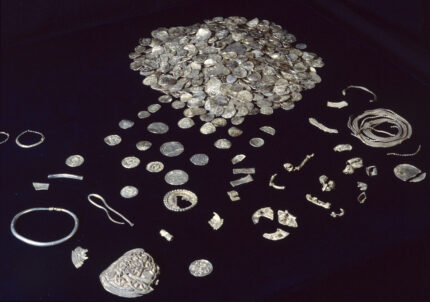Here’s an intriguing case of unintended consequences in cultural heritage law. Meet the Everlöv Hoard:
The Everlöv Hoard is a large group of more than 950 silver objects –912 coins, 40 pieces of jewelry — from the Viking Age discovered in southern Sweden’s Skåne province in the 1980s. The oldest coin dates to the 9th century, the youngest to 1018, indicating the hoard was assembled in the late Viking era. The composition of the objects mark them as a single deposition, but the original find site is unknown.
Many of coins are from Bavaria, which is unusual in Swedish hoards. The hoard also contains an unusually high number of Anglo-Scandinavian coins, ie, coins struck by Scandinavian kings in imitation of the ones struck by the king of England. Among the objects are several extremely rare pieces: a buckle with intricately enlaced zoomorphic figures decorated with filigree and granulation, a Slavic lunula and an oversized jewelry bracteate minted by Henry II, Holy Roman Emperor, aka Saint Henry the Exuberant.
The discovery was not made in the usual way; nobody found it by metal detecting or in a happy ploughing accident. It was not dug up at all, in fact. The current owner found it in a chiffonier that had been passed down through generations of the family. (Side note: finding a Viking silver hoard in an old piece furniture has to be in my top 3 greatest lifetime fantasies.)
The hoard was catalogued and briefly exhibited in 1986 at Lund University’s Historical Museum. The museum didn’t get to keep it, however. They didn’t even get to study it. The hoard remained in private hands and was never exhibited again nor made available to researchers.
According to the Swedish Historic Environment Law, any archaeological finds are property of the state and must be reported to county officials. The state can then choose whether to redeem them for a fee. A version of this law has been on the books for centuries, so whoever found this hoard and stashed it in the chiffonier was breaking the law, but that person has been dead a long time. If an ancient artifact qualifies as an inheritance — like, say, if it was found inside heirloom furniture — then ownership goes to the individual who found it.
The state tried to redeem the hoard anyway when it emerged in the 1980s, but the atypical circumstances made it a thorny legal issue and a court ruled that the hoard was owned by the person who found it in the chiffonier. As the law is currently written, there is no mechanism for the state to claim an archaeological object on the grounds of its cultural importance regardless of how or when it was discovered, so that was that. The hoard all but disappeared.
Earlier this month, news broke that the Everlöv Hoard would be sold at auction on April 29th. Even worse, it was being offered in individual lots, so the whole hoard could have been scattered to the four winds. An uproar ensued as archaeologists and researchers protested the sale. The hoard as a whole is far more significant than the sum of its parts, especially the Bavarian through-line which might indicate a previously unknown trade route linking Sweden and southern Germany. Besides, the case could create a dangerous precedent wherein bad actors could claim a fresh find was a surprise legacy.
Literally the day before the scheduled auction, the Everlöv Hoard was saved from dispersal by the Gunnar Ekström Foundation for Numismatic Research and the Sven Svensson Foundation for Numismatic Research who pooled their resources and bought the whole kit and kaboodle behind the scenes. The auction is off and the hoard will now enter the collection of the Royal Coin Cabinet at Stockholm’s Economy Museum where it can and will be studied to the nerdiest heart’s content.

Many coins are from “Bavaria”? :confused:
I am, however, not so sure if Henry II –the Saint and Emperor– may have been “Exuberant”, but he is not to be confused with his dad, i.e. Henry II, Duke of Bavaria, a.k.a. the “Quarrelsome”.
The younger Henry became emperor in 1014 and he grew up in the Bavarian bit of ‘Francia Orientalis’ and is buried there.
Maybe, it has to be pointed out that Scania, i.e. the southern bit of what today is Sweden, had back then been a province of Denmark.
I don’t know about Henry, but already in 810, Charlemagne had to deal with “Danes” that were marauding the North Sea, which Charlemagne planned to take care of with “Abul-Abbas”, his war elephant from Baghdad, but Abul-Abbas may have not liked the climate in Aachen. However, they only made it to “Lippeham”, where the elephant “suddenly died”.
:hattip:
————-
“…Imperator vero Aquisgrani adhuc agens et contra Godofridum regem expeditionem meditans nuntium accepit […], deinde transmisso Rheno flumine in loco, qui Lippeham vocatur, […] elefans ille, quem ei Aaron rex Sarracenorum miserat, subita morte periit.”
So Livius, I would love to know what your other archaeological fantasies are!